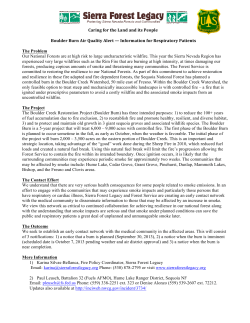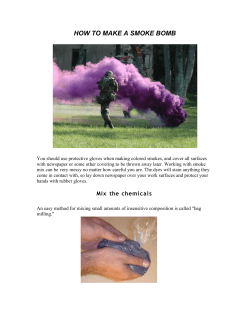
Handling Smoke Damage after a Chapter 13: Residential/Farm Fires
Chapter 13: Residential/Farm Fires Handling Smoke Damage after a Fire – Getting Soot and Smoke Out You may be anxious to clean your home after a fire, but unless you take the time to get professional advice, you may be wasting your efforts or creating further damage. Contact your insurance agency immediately once the fire is out. He or she can provide advice on restoration or replacement of damaged items. If you rent, notify the owner so both of you can assess the damage. “Be sure you have permission from your fire marshal to safely re-enter your home.” Your insurance agent may be able to recommend a professional fire restorer. Fire restorers can provide hints to prevent further damage, help determine which items can or cannot be refurbished, and provide estimates and services for thoroughly cleaning and deodorizing your home. Their services can be expensive, but the cost may be substantially less than the cost of replacing damaged furnishings and floors. You can find the names of fire restorers in the yellow pages of the phone directory under “Carpet and Upholstery Cleaners” or “Fire and Water Damage Restoration.” Preventing Further Damage Even if you don't hire a professional fire restorer, you can minimize further damage by following these guidelines. Be sure you have permission from your fire marshal to safely re-enter your home before doing so. This document is IFAS publication DH 1317. Adapted by UF/IFAS from: Disaster Handbook for Extension Agents (Wisconsin Cooperative Extension Service) Get the air moving. Open windows to ventilate areas. Install a fan to circulate air. Note: if there has been substantial water damage and the weather is warm, you will probably need to keep the windows shut and run a dehumidifier. In cold weather, your heating system is operating and the cold air will usually help remove the moisture. In this case, change your furnace filter daily until it shows no soot. Dry wet items as soon as possible. Use fans and dehumidifiers to dry carpets and draperies. If not thoroughly dried, carpets and The Disaster Handbook 1998 National Edition Institute of Food and Agricultural Sciences University of Florida Handling Smoke Damage after a Fire –Getting the Soot and Smoke Out Section 13.17 Page 1 floors underneath may be quickly damaged beyond repair by mold and mildew. Remove brass and copper items and clean them using brass or copper cleaner (smoke can etch brass or copper in 24 hours). Place aluminum foil or plastic food wrap under furniture legs. Remove oriental rugs or other colored rugs from wet wall-to-wall carpeting. Cover dry, clean items with plastic while repairs are in progress. “Smoke odor may remain in clothing, upholstered furniture, carpets and draperies unless they are properly deodorized before cleaning.” Removing Soot from Household Textiles Soot is oily and easily stains carpets, draperies and other household textiles. For this reason you must remove it before you attempt to clean or deodorize items. If possible, hire a professional restorer to remove soot with a heavy-duty vacuum. If you don't plan to hire a professional, you can remove some soot by holding a vaccum cleaner nozzle slightly off the surface of the item. Do not use vacuum attachments or an upright vacuum because the brushes tend to force soot into fabrics. Cover carpets after removing the soot to keep other soil from being tracked in during clean-up. Removing Smoke Odor from Textiles Smoke odor may remain in clothing, upholstered furniture, carpets and draperies unless they are properly deodorized before cleaning. Professional assistance is recommended. Consult professional fire restorers and/or dry cleaners about using "counteractants," chemicals or additives that break up smoke molecules to eliminate odors. The type of counteractant used will vary with the type of material burned in the fire. Counteractants may be professionally applied to furniture, carpets and draperies. Restorers also may provide them for laundering clothes. Fire restorers and dry cleaners sometimes use an ozone treatment to break up smoke molecules and eliminate odors. If the process is done in the home, items are put under a tent while an ozone generator is operating. The Disaster Handbook 1998 National Edition Institute of Food and Agricultural Sciences University of Florida Handling Smoke Damage after a Fire –Getting the Soot and Smoke Out Section 13.17 Page 2 Keep in mind that most household deodorizing sprays and disinfectants provide only temporary relief. In addition, deodorizing sprays may interact with smoke odor and create an additional odor. If you are unable to have clothing or similar textiles professionally treated, try one of the following methods: 1 Dissolve one cup of dishwashing detergent—the type used in an automatic dishwasher—in one gallon of warm water. Completely submerge the items and let them soak all night in your washing machine or bathtub. Drain and launder as usual the next day. 1 For items that can be bleached, mix 4 to 6 tablespoons trisodium phosphate (available from your hardware store) with 1 cup Lysol or household chlorine bleach and 1 gallon of water. Add clothes, rinse with clear water and dry. Cleaning Furnishings and Clothing “Have carpets cleaned twice–both before and after repairs.” After deodorizing, it's time to clean household textiles. Take nonwashable clothing and draperies to a dry cleaner for traditional dry cleaning or a special cleaning process. Wash regular clothing in warm water with a liquid detergent. Several launderings may be needed. Have carpets cleaned twice—both before and after repairs. Wet carpets must be dried before cleaning. In some cases, removal of carpet is necessary for complete drying and to save the wood floor beneath. Cleaning Soot Stains from Walls If possible, use a chemical sponge available from a cleaning supply company or some other non-water-based cleaner to clean soot from walls. Paint thinner or rubbing alcohol may work, but use with caution because of toxicity and fumes. Wear rubber gloves, open all windows and use an electric fan to increase ventilation while working. The Disaster Handbook 1998 National Edition Institute of Food and Agricultural Sciences University of Florida Handling Smoke Damage after a Fire –Getting the Soot and Smoke Out Section 13.17 Page 3 Do not use a water-based cleaner on plaster walls. It will cause the stain to bleed into the wall. Removing Smoke Odor from the Home During a fire, smoke can permeate walls and other surfaces and drift through household ducts, where it becomes trapped. If not properly removed, smoke odor reoccurs from time to time, especially during warm or damp weather. “Consult professional restorers about a process known as ‘thermal fogging’.” Consult professional restorers about a process known as "thermal fogging." This warm chemical fog penetrates your home and walls just as the fire did, neutralizing the smoke odor as it goes. Consult restorers about smoke removal from ducts. They may use a chemical sealer to secure smoke permanently to the sides of ducts since these areas, with their joints and crevices, may be difficult to clean with conventional vacuum-and-brush methods. Consider replacement of attic insulation. Insulation may retain odors. Additional Resources 1 1 1 1 Your local fire department The American Red Cross The National Institute of Fire Restoration The Federal Emergency Management Agency The Disaster Handbook 1998 National Edition Institute of Food and Agricultural Sciences University of Florida Handling Smoke Damage after a Fire –Getting the Soot and Smoke Out Section 13.17 Page 4
© Copyright 2025





















